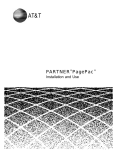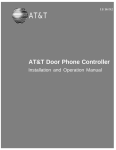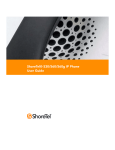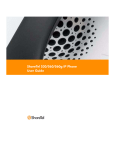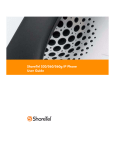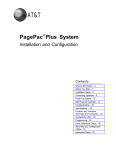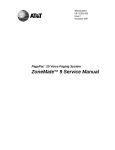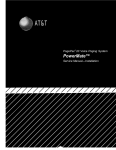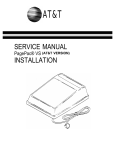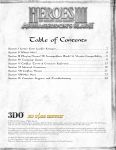Download AT&T PagePal 0II722050-917 User's Manual
Transcript
2/12/93 AT&T ® PagePal Installation Manual Copyright 1993, AT&T All Rights Resewed Printed in U.S.A. 0II722050-917 Issue 2, February 1993 No Part of this publication may be reproduced in a retrieval system, or transmitted, in any form or by any means, electronic, mechanical, photocopying, recording, or otherwise, without the prior written permission of AT&T. The use of trademarks or other designations is for reference purposes only. NOTICE Every effort was made to ensure that the information in this manual was complete and accurate at the time of printing. However, information is subject to change. COMPATIBILITY ® The AT&T PagePal is recommended for use with most AT&T telephone systems and commercial audio amplifiers used for public announcement. WARRANTY INFORMATION AT&T provides a limited warranty to this product. Refer to “Warranty Information” in Appendix A. ORDERING INFORMATION To order an additional PagePal, use Part Number 722050-917. To order this document, order Part Number 0II722050-917. PagePal is a registered trademark of HARRIS CORPORATION Dracon Division. CENTREX is a registered trademark of AT&T. The Canadian equivalent of the RJ11C connector is CA11A. Where applicable, CA11A is to be understood for other references to RJ11 or JR11C in this manual This product is UL Listed or CSA Certified. “NOTICE: The Canadian Department of Communications label identifies certified equipment. This certification means that the equipment meets certain telecommunications network protective operational and safety requirements. the Department does not guarantee the equipment will operate to the user’s satisfaction. “Before installing this equipment, users should ensure that it is permissible to be connected to the facilities of the local telecommunications company. The equipment must al SO be installed using an acceptable method of connection. In some cases, the company’s inside wiring associated with a singly line individual service may be extended by means of a certified connector assembly (telephone extension cord). The customer should be aware that compliance with the above conditions may not prevent degradation of service in some situations. “Repairs to certified equipment should be made by an authorized Canadian maintenance facility designated by the supplier. Any repairs or alterations made by the user to this equipment, or equipment malfunctions, may give the telecommunications company cause to request the user to disconnect the equipment. “USerS should ensure for their own protection that the electrical ground connections of the power utility, telephone lines and internal metallic water pipe system, if present, are connected together. This precaution may be particularly important in rural areas. Caution: Users should not attempt t O make such connections themselves, should contact the appropriate electric inspection authority, or electronics, as appropriate.” VG—2/93—2M ii Contents 1 AT&T PagePal System Overview 1-1 ■ Description ■ Features 1-2 1-3 Installation 2-1 ■ Important Safety Instructions ■ General Information ■ Troubleshooting Guide 2-2 2-4 2-12 A FCC Regulations and Warranty A-1 B AT&T PagePal Functional Diagram B-1 C Secondary Circuit Protection C-1 2 iii ® AT&T PagePal System Overview 1 AT&T PagePal System Overview 1-1 Descrption ® The AT&T PagePal unit has been designed to interface most ® telephone systems (PBX, KTS, Centrex ) to virtually any public address audio system. In addition, PagePal furnishes inputs for customer provided background music and auxiliary inputs (such as an attendant microphone, a radio receiver, recorded announcements, etc.) Control inputs are provided for tones generated by PagePal such as pre-announcement tones, telephone access confirmation, siren, chime, and night bell. All inputs are automatically selected on a prioritized basis and routed to a single output which will drive any type of audio equipment. PagePal can be placed on a desk or shelf, or mounted to a wall (see installation section). GS LEVEL CONTROLS AT&T MUSIC INPUT ATTENDANT INPUT MAIN OUTPUT LS DL PagePal Figure 1-1. Front View of the AT&T PagePal 1-2 AT&T PagePal System Overview SA ® Features The AT&T PagePal provides many useful features: ■ Telephone Access from: – – – Loop Start trunks Ground Start trunks Analog Station Lines, PBX or Centrex Dry Loop page ports (4-wire). ■ Provides a point of clear demarcation between the telephone system and the audio system ■ FCC registered and UL Listed ■ Main output level control allows adjustment for commercial power amplifiers or consumer (home Hi-Fi) or specialized telephone paging amps ■ Level controls to set Attendant Input and Background Music, relative to telephone level ■ Balanced audio inputs and outputs eliminate hum and noise pick-up ■ High quality circuitry for low distortion and wide bandwidth ■ Simplified connections via modular telephone jack and Iugless terminal block ■ Inputs are routed to the output with the following priority (highest to lowest): 1. Attendant Access for emergency and other important announcements 2. Alert Tone 1 (siren) for evacuation warning, etc. 3. Telephone Access for general purpose paging 4. Alert Tone 2 (chime) for time clock, door bell, security alert, etc. 5. Nightbell for incoming, after-hours calls to ring audibly over the public address system 6. Music input for background music ■ Over-ride or busy tone is returned to the telephone user in the event of a higher priority AT&T PagePal System Overview 1-3 ■ Call Confirmation and Pre-Announcement tones may be disabled ■ An optional contact closure output is provided to control auxiliary equipment (music/page switching, recorder logging, etc.) ■ Station access mode features: 1. VOX (Voice Operated Switch) controlled off-hook timer 2. Maximum length off-hook timer 3. Responds to forward disconnect (Calling Party Controlled Disconnect) 4. Dial tone detection and disconnect 5. Open Interval Protection (OIP). 1-4 AT&T PagePal System Overview Installation 2 Installation 2-1 Important Safety Instructions When using your telephone equipment, basic safety precautions should always be followed to reduce the risk of fire, electric shock and injury to persons, including the following: 1. Read and understand all instructions. 2. Follow all warnings and instructions marked on the product. 3. Unplug this product from the wall outlet before cleaning. Do not use liquid cleaners or aerosol cleaners. Use a damp cloth for cleaning. 4. Do not use this product near water, for example, near a bath tub, wash bowl, kitchen sink, or laundry tub, in a wet basement, or near a swimming pool. 5. Do not place this product on an unstable cart, stand, or table. The product may fall, causing serious damage to the product. 6. Slots and openings in the cabinet and the back or bottom are provided for ventilation, to protect the product from overheating. These openings must not be blocked or covered. The openings should never be blocked by placing the product on the bed, sofa, rug, or other similar surface. This product should never be placed near or over a radiator or heat register. This product should not be placed in a built-in installation unless proper ventilation is provided. 7. This product should be operated only from the type of power source indicated on the marking label. If you are not sure of the type of power supply to your building, consult your dealer or local power company. 2-2 Installation 8. WARNING: RISK OF ELECTRICAL SHOCK — EQUIPMENT MUST BE PROPERLY GROUNDED. Your Harris equipment requires a properly grounded three-prong power receptacle for safe operation. Have the receptacle checked by a qualified electrician before connecting this equipment. Do not cut or remove the third (ground) prong from the power transformer. Do not use two-prong extension cords or adapters to defeat the safety features of this equipment. If you have a two-prong receptacle, it must be replaced with a three-prong receptacle, installed by a qualified electrician. 9. Do not allow anything to rest on the power cord. Do not locate this product where the cord will be abused by persons walking on it. 10. Do not overload wall outlets and extension cords as this can result in the risk of fire or electric shock. 11. Never push objects of any kind into this product through cabinet slots as they may touch dangerous voltage points or short out parts that could result in a risk of fire or electric shock. Never spill liquid of any kind on the product. 12. To reduce the risk of electric shock, do not disassemble this product, but take it to a qualified serviceman when service or repair work is required. Opening or removing covers may expose you to dangerous voltages or other risks. Incorrect reassembly can cause electric shock when the appliance is subsequently used. 13. Unplug this product from the wall outlet and refer servicing to qualified service personnel under the following conditions: A. When the power supply cord or plug is damaged or frayed. B. If liquid has been spilled into the product. Installation 2-3 C. If the product has been exposed to rain or water. D. If the product does not operate normally by following the operating instructions. Adjust only those controls that are covered by the operating instructions. Improper adjustment of other controls may result in damage and will often require extensive work by a qualified technician to restore the product to normal operation. E. If the product has been dropped or the cabinet has been damaged. F . If the product exhibits a distinct change in performance. 14. Avoid using a telephone (other than a cordless type) during an electrical storm. There may be a remote risk of electric shock from lightning. 15. Do not use the telephone to report a gas leak in the vicinity of the leak. SAVE THESE INSTRUCTIONS. General Information Please adhere to the following precautions: 1. Never install telephone wiring during a lightning storm. 2. Never install telephone jacks in wet locations unless the jack is specifically designed for wet locations. 3. Never touch uninsulated telephone wires or terminals unless the telephone line has been disconnected at the network interface. 4. Use caution when installing or modifying telephone lines. 2-4 Installation Recorder Logging A tape recording may be desirable for evidence to prove that certain announcements or warnings were made over the paging system. The normally open contacts (terminals 16 & 17, see Figure 2-1) may be used to activate a tape recorder to record all tones and announcements that were made, without the background music in between which would consume large amounts of tape. Balanced to Unbalanced The balanced inputs of the AT&T PagePal may be driven by an unbalanced source. Simply connect the two wires to the + and – input terminals. Unbalanced inputs to power amplifiers may be driven from the PagePal’s balanced output by connecting the PagePal ground (terminal 14, see Figure 2-1) to the input ground of the power amp, and the + or – output (terminal 13 and 15, see Figure 2-1) of PagePal to the “hot” input pin of the power amp. However, the output level will be 6dB less. Connections The PagePal provides four connectors on the unit’s back panel (see Figure 2-1). The following information describes each of the connectors and their function. Modular Telephone Jack This is a standard 6-pin telephone Modular type connector, located at J1 on the unit back panel. See Table 2-1 for a description of each of the pins. Installation 2-5 MICROPHONE TO LOUDSPEAKERS PREAMP MUSIC SOURCE PUBLIC ADDRESS AUDIO SYSTEM RECORDED ANNOUNCEMENTS TYPICAL INPUTS RADIO RECEIVER POWER AMPLIFIER(S) SIGNAL PROCESSING CONTROL CLOSE FOR ATTENDANT ACCESS STATION OR KEY TELEPHONE SYSTEM, PRE-PROGRAMMED FOR NIGHT BELL PHONE SYSTEM TO AC OUTLET PAGEPAL Figure 2-1. Typical Connections to the AT&T PagePal Connectors (Rear Panel View) 2-6 Installation Table 2-1. AT&T PagePal J1 Modular Telephone Jack Pin Number Description 1 Not Used. 2 C1 control input for Dry Loop (Page Port) activation by closure (may also be used for Ground Start grounding point). 3 Ring (– polarity is important for Ground Start). 4 Tip (+ polarity is important for Ground Start). 5 C control input for Dry Loop (Page Port) activation by contact closure. 6 Not Used. Terminal Block Connector This is a 20 Pin lug less-type terminal block located at J2 (see Figure 2-1). See Table 2-2 for a contact descriptions. Factory Test Connector Wall Plug Transformer J3 - No user connections -115 VAC, 60 Hz. — U.L. Listed. Installation 2-7 Table 2-2. AT&T PagePal J2 Terminal Block Connector Terminal 2-8 Description 1 Ground for ground start ground/Common connection for terminals 2-6. 2 Close a contact between this terminal and J2-1 to activate Attendant Access. 3 Close a contact between this terminal and J2-1 to active TONE 1. 4 Close a contact between this terminal and J2-1 to activate TONE 2. 5 Connect a jumper between this terminal and J2-1 to disable confirmation and pre-announcement tones. 6 Connect a jumper between this terminal and J2-1 to disable the pre-announcement tone. 7 Attendant input, + phase of balanced 600 ohm input. 8 Ground for optional shield termination of Attendant Input. 9 Attendant Input, – phase of balanced 600 ohm input. 10 Music Input, + phase of balanced 100 Kohm input. 11 Ground for optional shield termination of Music Input. 12 Music Input, – phase of balance 100 Kohm input. 13 Audio Output to paging system, + phase of balanced output, 300 ohm. 14 Ground for optional shield termination of output. 15 Audio Output to paging system, – phase of balanced output, 300 ohm. 16 Normally open contact (with J2-17) that may be used to activate paging equipment. 17 Normally open contact (with J2-16). Contact is closed when any input with priority higher than music is present. 18 Night bell Input from Key systems. Night bell is activated by any low voltage greater than 10V AC/DC. 19 Common terminal for night bell input voltage. (Tip) 20 Night bell input from ringer voltage. REN=0.5, Type B. (Ring). In Canada: DOC Load Number = 22. Installation Wall Mount Instructions 1. Determine where the desired wall mounting location should be. 2. Drive the screw into the wall, leaving 3/16'' space between the wall and the bottom of the screw head (see Figure 2-2). 3. Mount the PagePal keyhole slot over the screw head. Adjust the screw depth so that the rubber feet seat firmly against the wall. 4. Temporarily remove the PagePal while attaching wiring to the terminal block. PAGEPAL PAGEPAL MOUNTING HOLE 3/16'' WALL SURFACE Figure 2-2. Wall Mounting Installation 2-9 Adjustments Slide Switch This four-position switch is provided to configure the AT&T PagePal for the appropriate mode of telephone access. See Figure 1-1. LS-Loop Start PBX trunk or a dedicated phone set Note: With the switch in this position, the PagePal is optioned to interface with a Loop Start trunk of a PBX or Line Port of Key System. In this mode, the PagePal supplies the “talk battery” on Tip and Ring. GS-Ground Start PBX ground start trunk Note: With the switch in this position, the PagePal is optioned to interface with a Ground Start trunk of a PBX. in this mode it is imperative that the PBX ground be connected to Pin 1 of the 20 pin connector on the PagePal or pin 2 of the RJ11 connector on the PagePal. In addition, the PagePal supplies the “talk battery” on Tip and Ring after the PBX has supplied a “hand shake” to the PagePal by momentarily grounding the Ring lead. NOTE: PagePal must be connected to CWP ground at J2-1. SA-Station Access PBX station line or Central Office subscriber line Note: With the switch in this position, the PagePal is optioned to interface with a CENTREX, PBX or Key System ANALOG station. In this mode the PagePal wants to receive “talk battery” and ring voltage from the host system that it is connected to. DL-Dry Loop PBX page ports or auxiliary pac Note: With the Switch in this position, the PagePal is optioned to interface with the Page Port of a Key System or an Auxiliary Pac of a PBX. Dry Loop is a 4 wire connection, pins 2 and 5 of the RJ11 are intended to interface with the control leads of the host system, while Tip and Ring connect to the usual pins 3 and 4 of the RJ11. In this mode the PagePal will not have “talk battery” on its Tip and Ring and will not expect to see “talk battery” on the host systems Tip and Ring. 2-10 Installation Level Controls Main Output Adjusts level of output. Full counter-clockwise rotation provides unity gain from Telephone input to PagePal output. This is best for driving AT&T PagePals, or consumer (home Hi-Fi) type amplifiers. Full clockwise rotation provides 14dB gain.* This will be more appropriate commercial-industrial sound equipment. Refer to the specifications of your power amplifier for the appropriate input level, or experiment with the adjustments for best results. Set the Main Output level first using telephone input, then adjust Attendant and Music inputs for an appropriate relative level. (Telephone input signals are typically -15 to -10dBm.) Attendant Input Adjusts level of Attendant Input relative to the Telephone Input. Adjustment range is from 0dB to less than -30dB. Music Input Adjusts the level of Music Input relative to Telephone Input. Adjustment range is from 0dB to less than -30dB. *Gain assumes that the balanced output is driving 600 ohms. (See block diagram in Appendix B for gain structure.) Installation 2-11 Troubleshooting Use Table 2-3 to assist in locating possible problems. Table 2-3. AT&T PagePal Troubleshooting Suggestions Problem Troubleshooting Steps Solution Green LED flashes. The LED flashes approximately two times per second when the unit is operating normally. No action required. Green LED glows steady. This indicates that the control logic is re-setting itself. Unplug the unit for five seconds, then plug it in again. This will re-start the unit. If LED still glows steady, return the unit for repair. No music source connected to the input, but there is noise on the output in the music mode. Turn the Music Input volume control to the full counter clockwise position. Leave the volume control turned down if no music source is to be used. Hum, buzz or noise on the output in the music mode with a music source connected in a unbalanced configuration. Using a piece of wire, short the un-used music input pin to pin 11 of J2. If the problem is fixed, leave the pins connected. No music on the output with a music source connected to the input. Check the volume control level. Adjust as needed. A higher priority in the PagePal is active. Verify and correct if needed. Check the input and output connections. Verify and correct if needed. 2-12 Installation Table 2-3. AT&T PagePal Troubleshooting Suggestions (continued) Problem Night Bell is not active when it is intended to be activated with a low AC or DC voltage. Night Bell is not active when it is intended to be activated with a Ring voltage. Alert Tone 2 is not functioning. Troubleshooting Steps Solution The input voltage level is too low or missing. Must be greater than 10 VAC or VDC. Make sure that the input connections are to pins 18 and 19 of J2 (polarity is important). Verify and correct if needed. A higher priority in the PagePal is active. Verify and correct if needed. Check the MAIN OUTPUT volume control setting. Correct if needed. The input voltage level is too low or missing. Must be greater than 40 VAC Make sure that the input connections are to pins 19 and 20 of J2. Correct if needed. A higher priority in the PagePal is active. Verify and correct if needed. Check the MAIN OUTPUT volume control setting. Correct if needed. Check the connection to the back panel, pins 1 and 4 of J2. Correct if needed. Check the MAIN OUTPUT volume control setting. Correct if needed. Verify using an Ohm meter that a contact closure is being provided from the host equipment. Correct if needed. A higher priority in the PagePal is active. Verify and correct if needed. Installation 2-13 Table 2-3. PagePal Troubleshooting Suggestions (continued) Problem Troubleshooting Steps Solution Relay chatter when Tip and Ring is connected to the PagePal. Verify that the Telephone Access Switch is in the proper position for the application. Change the Telephone Access Switch to the appropriate position. When using the PagePal in the Page Port mode a busy tone is returned when attempting to access the PagePal. Verify that the Telephone Access Switch is in the proper position for the application. Change the Telephone Access Switch to the DL position. Verify that Attendant Access is not active. Wait for the Attendant Access to de-activate. Verify that the host telephone system’s ground is connected to Pin 1 of J2 on the PagePal or Pin 2 or the RJ-11 jack. Connect the ground. Verify that the Telephone Access Switch is in the proper position for the application. Change the Telephone Access Switch to the GS position. Tip and Ring may be reversed (the Ring is always more negative than the Tip). If reversed, swap Tip and Ring. Excessive loop length. Must be less than 1200 ohms. The PagePal answers a station call, then immediately hangs up. Verify that the Telephone Access Switch is in the proper position for the application (SA not GS). Change the Telephone Access Switch to the SA position. Dial tone or confirmation tone is sent to the speaker when the PagePal has not been accessed. The Telephone Access Switch’s position may have been changed while the Tip and Ring was connected. Remove the Tip and Ring connection. Verify what mode of operation is desired. Change the Telephone Access Switch to the proper position. Re-install Tip and Ring. The PagePal is not being accessed in the Ground Start mode. 2-14 Installation Table 2-3. AT&T PagePal Troubleshooting Suggestions (continued) Problem Troubleshooting Steps Dry loop (Page Port) mode won’t access PagePal. Pins 2 and 5 of the RJ11 connector must be closed by a contact in the PBX when access is desired. Verify that this connection is made. Alert Tone 1 is not functioning. Check the connection to the back panel, pins 1 and 3 of J2. Correct if needed. Check the MAIN OUTPUT volume control setting. Correct if needed. Verify using an Ohm meter that a contact closure is being provided from the host equipment. Correct if needed. A higher priority in the PagePal is active. Verify and correct if needed. Check the connection to the back panel, pins 1 and 2 of J2. Correct if needed. Check the MAIN OUTPUT volume control setting. Correct if needed. Check the ATTENDANT INPUT volume control setting. Correct if needed. Verify using an Ohm meter that a contact closure is being provided from the host equipment. Verify and correct if needed. Turn the Attendant Input volume control to the full counter clockwise position. Leave the volume control turned down if no Attendant Access source is to be used. Attendant Access is not functioning. No Attendant Access source connected to the input, but there is noise on the output in the Attendant Access mode. Solution Installation 2-15 Table 2-3. AT&T PagePal Troubleshooting Suggestions (continued) Problem Troubleshooting Steps Solution Hum, buzz or noise on the output in the Attendant Access mode with a Attendant Access source connected in a unbalanced configuration. Using a piece of wire, short the un-used Attendant Access input pin to pin 8 of J2. If the problem is fixed, leave the pins connected. No pre-announce tone is sent to the output, but it is desired. A jumper has been installed on pins 1 and 6 of J2. Remove the jumper. No pre-announce or confirmation tone is sent to the output or the telephone, but it is desired. A jumper has been installed on pins 1 and 5 of J2. Remove the jumper. No power LED. Using a Voltmeter, check for AC Voltage at the wall outlet. Correct facilities problem. Bad wall plug-in power supply on the PagePal. Return the PagePal to the proper location for repair. Adjust gain controls. Adjust as needed. The wrong impedance is attached to the output. Ideally the PagePal would like to drive a 600 Ohm impedance, however by using the Main Output volume control, various impedances can be used. Low Volume on the output. 2-16 Installation Appendix A—FCC Regulations and Warranty FCC Regulations—Part 15 Radio Frequency Interference The AT&T PagePal generates and uses radio frequency energy and if not installed and used in strict accordance with the manufacturer’s instructions, may cause interference to radio and television reception. Testing has been conducted for compliance with the limits for Class B device in accordance with the specifications in Subpart J of Part 15 of the FCC Rules. This testing is designed to provide reasonable protection against such interference. However, there is no guarantee that interference will not occur in a particular installation. If this equipment does cause interference to radio or television reception, which can be determined by turning the unit off and on, the user is encouraged to try to correct the interference by one or more of the following measures: ● ● Reorient the radio or TV receiving antenna. Relocate the PagePac 6 Plus with respect to the radio or TV receiver or vice-versa. ● Plug the PagePac 6 Plus into a different outlet so that it and the radio or TV receiver are on different branch circuits. ● If necessary, the user should consult the dealer or an experienced radio/television technician for additional suggestions. The user may find the following booklet, “How To Identify and Resolve Radio-TV Interference Problems,” helpful. This booklet was prepared by the Federal Government Printing Office, Washington, DC 20402. Stock order No. 004-000-00345-4. A-1 FCC Regulations—Part 68 This equipment is registered with the Federal Communications Commission (FCC) in accordance with Part 68 of its Rules. The FCC requires that the manufacturer provide you with the following information: 1. Connection and Use with Nationwide Telephone Network The FCC requires that you connect your telephone equipment to the nationwide telephone network through a modular telephone outlet or jack. The modular telephone outlet or jack to which the equipment must be connected is a USOC RJ11C. Registered equipment may not be used with Coin Telephone Lines. Equipment may be used with Party Lines in areas where state tariffs permit such connections and when equipment is adaptable for such use. 2. Information You May Need to Supply the Telephone Company Upon request of your local telephone company, you are required to provide them with the following information: A. The lines to which you will connect the telephone equipment. B. The FCC registration number and Ringer Equivalence Number (REN). Both numbers are listed on the equipment label. The REN is useful to determine how many devices you may connect to your telephone line and still have them ring when your telephone line is called. In most, but not all, areas, the sum of all RENs per line should be 5 or less. You may want to contact your local telephone company. The local telephone company must also be notified upon final disconnection of the equipment from the local telephone company lines. A-2 ● Failure to follow AT&T's installation, operation or maintenance instructions; ● Unauthorized modification or alteration of the product or its components; ● Product abuse, misuse or the negligent acts of persons not under the reasonable control of AT&T; ● Actions of third parties and acts of God other than power surges (e.g., lightning). This limited warranty applies only to the product purchased directly from AT&T or purchased directly from an authorized AT&T dealer. This limited warranty does not apply to products purchased or operated outside the United States. You may be required to provide AT&T with proof of purchase before AT&T will perform any warranty repair or provide any warranty replacements. EXCEPT AS SPECIFICALLY SET FORTH ABOVE, AT&T, ITS AFFILIATES, SUPPLIERS AND DEALERS MAKE NO WARRANTIES, EXPRESS OR IMPLIED, AND SPECIFICALLY DISCLAIM ANY WARRANTY OF MERCHANTABILITY OR FITNESS FOR A PARTICULAR PURPOSE. EXCEPT FOR PERSONAL INJURY, THE LIABILITY OF AT&T, ITS AFFILIATES, SUPPLIERS AND DEALERS FOR ANY CLAIM, LOSS, DAMAGE OR EXPENSE FROM ANY CAUSE WHATSOEVER, REGARDLESS OF THE FORM OF THE ACTION, WHETHER IN CONTRACT, TORT OR OTHERWISE, SHALL NOT EXCEED THE LESSER OF DIRECT DAMAGES PROVEN OR THE REPAIR OR REPLACEMENT COST OF THE SYSTEM OR THE SYSTEM’S PURCHASE PRICE. IN NO EVENT SHALL AT&T, ITS AFFILIATES, SUPPLIERS AND DEALERS BE LIABLE FOR INCIDENTAL, RELIANCE, CONSEQUENTIAL OR ANY OTHER INDIRECT LOSS OR DAMAGE (INCLUDING LOST PROFITS OR REVENUES SUSTAINED OR INCURRED IN CONNECTION WITH THE SYSTEM). THIS LIMITATION OF LIABILITY SHALL SURVIVE FAILURE OF THE EXCLUSIVE REMEDY SET FORTH IN THE LIMITED WARRANTY ABOVE. A-4 In Canada, the DOC registration number and Load Number appear on the maple-leaf label, and the Load Number is under the maple-leaf label. Warranty Information Limited Warranty and Limitation of Liability AT&T warrants to you that the product will be free from defects in material and workmanship when title passes to you. If you notify AT&T that the product has failed to operate as warranted within one year of the date title passes to you, AT&T will, at its option, repair or replace the component or components of the product that failed to operate as warranted. Any repair or replacement components may be new or refurbished and will be provided on an exchange basis. If AT&T determines that the product cannot be replaced, AT&T will refund the purchase price to you. If you purchased the product directly from AT&T, AT&T will perform warranty repair on your premises in accordance with the terms and conditions of AT&T’s “Business Day” or “Around-the-Clock” warranty plans. The details of AT&T’s warranty plans may be obtained from AT&T. If you purchased the product from an authorized dealer, you will be covered by AT&T’s authorized dealer warranty plan during the warranty period. Contact your authorized dealer for details of AT&T’s authorized dealer warranty plan. AT&T’s obligation to repair, replace or refund as set forth above is your exclusive remedy. The limited warranties provided above do not cover damages, defects, malfunctions or product failures caused by: A-3 Installation and Maintenance Information There are several types of installation and maintenance plans available from AT&T and/or your dealer. Please call your AT&T sales representative or authorized dealer for details. For warranty service, contact your AT&T representative or authorized dealer. A-5 Appendix B—AT&T PagePal Functional Diagram PAGING EQUIPMENT INTERFACE (PagePal) I I DRY LINE LEVEL INPUT WITH I I CONTACT CLOSURE FROM P1 CONTACTS AMPLIFIED MIC, RECORDED I I ANNOUNCEMENTS, RADIO, P1 I I ATTENDANT INPUT LEVEL ETC. 600 OHM 0dB I I I I P6 I I MUSIC INPUT LEVEL 100K OHM 0dB MUSIC SOURCE I I I I 300 OHMS I OUTPUT TO I 20dB TELEPHONE INTERFACE I POWER AMP(s) I 300 OHMS TIP I I RING P3 I I CLOSED @ P1 THROUGH P5 I I REMOTE AMP C I CONTROL I C1 I I I I I I TONE 1 CONTACT CLOSURE TONE GEN P2, 4, or 5 TONE 2 I I OPTION JUMPERS CONTACT CLOSURE CONTACT CLOSURE NIGHT BELL I I RING DETECT POWER SUPPLY & OTHER TONES I 115 VAC NIGHT SELL I AC/DC DETECT I I I— — — — — — — — — — — — — — — — — — — — — — — — — — — — — — I ————————————————————————————————— LOOP START or GROUND START -24VDC TALK BATTERY STATION or CENTREX VOX TIMEOUT MAX. TIMEOUT DRY LOOP (PAGE PORT) Figure B-1. AT&T PagePal Functional Diagram B-1 Appendix C—Secondary Circuit Protection Important Information This equipment is for use on telephone wiring containing a secondary circuit protector. This paging equipment requires a Harris Dracon model 22060-930 PageGuard Secondary Circuit Protector where applicable (see Figure C-1). Each PagePac unit is supplied with a PageGuard protector factory-installed on the principal Tip-Ring pair. Each terminal pair on Terminal Strip “B” (see Figure C-2 of the PagePac manual) that is to be connected to any wires that go off premises must be supplied with an additional PageGuard protector. The secondary circuit protector must be located between the primary protector and the paging equipment. Refer to the Safety Information and Installation Steps below. Safety Information ■ The PageGuard is used when connecting paging equipment directly to telephone lines that maybe exposed to high voltage power lines. ■ Never install telephone wiring during a lightning storm. ■ Never install telephone jacks in wet locations unless the jack is specifically designed for wet locations. ■ Never touch uninsulated telephone wires or terminals unless the telephone line has been disconnected at the network interface. ■ Use caution when installing or modifying telephone lines. Secondary Circuit Protection C-1 PROVIDED BY TELCO TELCO DEMARCATION MAIN BUILDING A B BUILDING #2 PAGING EQUIP. B A A B PAGING EQUIP. PAGING EQUIP. CO LINES PROVIDED BY TELCO PROTECTION LOCATIONS A = PRIMARY CIRCUIT PROTECTOR B = SECONDARY CIRCUIT PROTECTOR U.L. SPECS 497 497A Figure C-1. Example Configurations Requiring Secondary Protection When Paging Equipment is Connected Directly to the Telephone Network Installation Steps Save these instructions. 1. Connect the green wire on PageGuard to earth ground. To un-install the PageGuard reverse order of these steps. 2. Plug a modular connector from the paging equipment telephone line interface to the modular connector on the PageGuard. 3. Install the PageGuard modular plug to the C.O. telephone lines (see Figure C-2). C-2 Secondary Circuit Protection TELEPHONE EQUIPMENT CONNECTED TO NETWORK CONNECT MODULAR PLUG TO TELEPHONE LINES (i.e., PBX/KTS/CENTREX) OUT TO SPEAKERS CONNECT GREEN WIRE TO EARTH GROUND PAGEGUARD (P/N 22060-930) NOT INCLUDED PAGING EQUIPMENT (POWERMATE) TO INPUT SIDE OF PAGING EQUIPMENT PGEGRD.DRW 10/22/91 Figure C-2. PageGuard Installation Secondary Circuit Protection C-3 SELECT CODE 468-248-101 ©1993 AT&T All Rights Reserved Printed in U.S.A. 0II722050-917 Issue 2, February 1993 Graphics © AT&T 1988

































